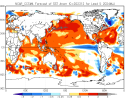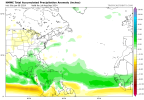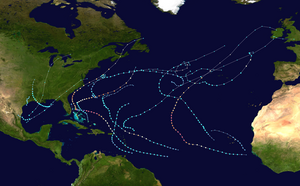JPWX
Member
I'm starting the 2024 Atlantic Hurricane Season thread. Below are my OWN thoughts based on what I'm seeing. Basically what I'm saying is I've done my research.
• THE OCTOBER, NOVEMBER, AND DECEMBER 2023 RUN'S OF THE CANSIPS MODEL SHOWS ANOTHER ACTIVE TO VERY ACTIVE HURRICANE SEASON. THIS MODEL HAS SERVED ME WELL SINCE I STARTED USING IT IN 2017.
•IF THIS IS CORRECT, YOU WOULD SEE A PATTERN SIMILAR TO THAT OF 2017 AND OTHER BIG YEARS (04,05, ETC), LONG TRACKED CAPE VERDE HURRICANES AND ENHANCED RISK OF LANDFALLS FROM THE CARIBBEAN, GULF, AND SOUTHEAST U.S. (CAROLINAS TO FLORIDA).
THE IDEA OF A TRANSITION BACK TO A LA NINA IS GROWING AND ALL 3 (OCTOBER-DECEMBER) OF THE CANSIPS RUNS SHOW THIS. A CENTRAL PACIFIC MODOKI BASED LA NINA.
HERE’S THE LIST OF MODOKI LA NINA’S:
•1973-74, 1975-76, 1983-84, 1988-89, 1998-99, 2000-01, 2008-09, 2010-11, AND 2016-17
•THE IDEA OF A TRANSITION BACK TO A LA NINA (MODOKI) IS ON THE TABLE. LEADING TO ANOTHER VERY TO EXTREMELY ACTIVE ATLANTIC HURRICANE SEASON THIS TIME WITH THE RETURN OF MULTIPLE CLASSIC CAPE VERDE LONG TRACKERS. (Something that's been missing since 2017)
•TOTAL STORMS: 12-25 (MY FORECAST MADE ON OCTOBER 1ST, 2023)
•HURRICANES: 8-16 (MY FORECAST MADE ON OCTOBER 1ST, 2023)
•MAJOR HURRICANES: 5-12 (MY FORECAST MADE ON OCTOBER 1ST, 2023)
•TOTAL ACE: 190 TO 230 RANGE (MY FORECAST MADE ON OCTOBER 1ST, 2023)
• THE OCTOBER, NOVEMBER, AND DECEMBER 2023 RUN'S OF THE CANSIPS MODEL SHOWS ANOTHER ACTIVE TO VERY ACTIVE HURRICANE SEASON. THIS MODEL HAS SERVED ME WELL SINCE I STARTED USING IT IN 2017.
•IF THIS IS CORRECT, YOU WOULD SEE A PATTERN SIMILAR TO THAT OF 2017 AND OTHER BIG YEARS (04,05, ETC), LONG TRACKED CAPE VERDE HURRICANES AND ENHANCED RISK OF LANDFALLS FROM THE CARIBBEAN, GULF, AND SOUTHEAST U.S. (CAROLINAS TO FLORIDA).
THE IDEA OF A TRANSITION BACK TO A LA NINA IS GROWING AND ALL 3 (OCTOBER-DECEMBER) OF THE CANSIPS RUNS SHOW THIS. A CENTRAL PACIFIC MODOKI BASED LA NINA.
HERE’S THE LIST OF MODOKI LA NINA’S:
•1973-74, 1975-76, 1983-84, 1988-89, 1998-99, 2000-01, 2008-09, 2010-11, AND 2016-17
•THE IDEA OF A TRANSITION BACK TO A LA NINA (MODOKI) IS ON THE TABLE. LEADING TO ANOTHER VERY TO EXTREMELY ACTIVE ATLANTIC HURRICANE SEASON THIS TIME WITH THE RETURN OF MULTIPLE CLASSIC CAPE VERDE LONG TRACKERS. (Something that's been missing since 2017)
•TOTAL STORMS: 12-25 (MY FORECAST MADE ON OCTOBER 1ST, 2023)
•HURRICANES: 8-16 (MY FORECAST MADE ON OCTOBER 1ST, 2023)
•MAJOR HURRICANES: 5-12 (MY FORECAST MADE ON OCTOBER 1ST, 2023)
•TOTAL ACE: 190 TO 230 RANGE (MY FORECAST MADE ON OCTOBER 1ST, 2023)
Attachments
-
 cansips-all-avg-exatl-precip_anom_season_mostrecent-5148800.png 3.png95.8 KB · Views: 0
cansips-all-avg-exatl-precip_anom_season_mostrecent-5148800.png 3.png95.8 KB · Views: 0 -
 cansips-all-avg-exatl-precip_anom_season_mostrecent-2470400 (2).png93.5 KB · Views: 0
cansips-all-avg-exatl-precip_anom_season_mostrecent-2470400 (2).png93.5 KB · Views: 0 -
 cansips-all-avg-exatl-precip_anom_season_mostrecent-7200000.png90.8 KB · Views: 0
cansips-all-avg-exatl-precip_anom_season_mostrecent-7200000.png90.8 KB · Views: 0 -
 cansips-all-avg-exatl-sst_anom_season_mostrecent-0419200.png78.8 KB · Views: 0
cansips-all-avg-exatl-sst_anom_season_mostrecent-0419200.png78.8 KB · Views: 0 -
 cansips-all-avg-exatl-mslp_anom_season_mostrecent-0419200.png94.6 KB · Views: 0
cansips-all-avg-exatl-mslp_anom_season_mostrecent-0419200.png94.6 KB · Views: 0 -
 cansips-all-avg-exatl-z500_anom_season_mostrecent-0419200.png92.9 KB · Views: 0
cansips-all-avg-exatl-z500_anom_season_mostrecent-0419200.png92.9 KB · Views: 0 -
 cansips-all-avg-pac_whole-sst_anom_season_mostrecent-0419200.png46.1 KB · Views: 0
cansips-all-avg-pac_whole-sst_anom_season_mostrecent-0419200.png46.1 KB · Views: 0 -
 cansips-all-avg-exatl-precip_anom_season_mostrecent-7740800.png 4.png95.5 KB · Views: 0
cansips-all-avg-exatl-precip_anom_season_mostrecent-7740800.png 4.png95.5 KB · Views: 0






















